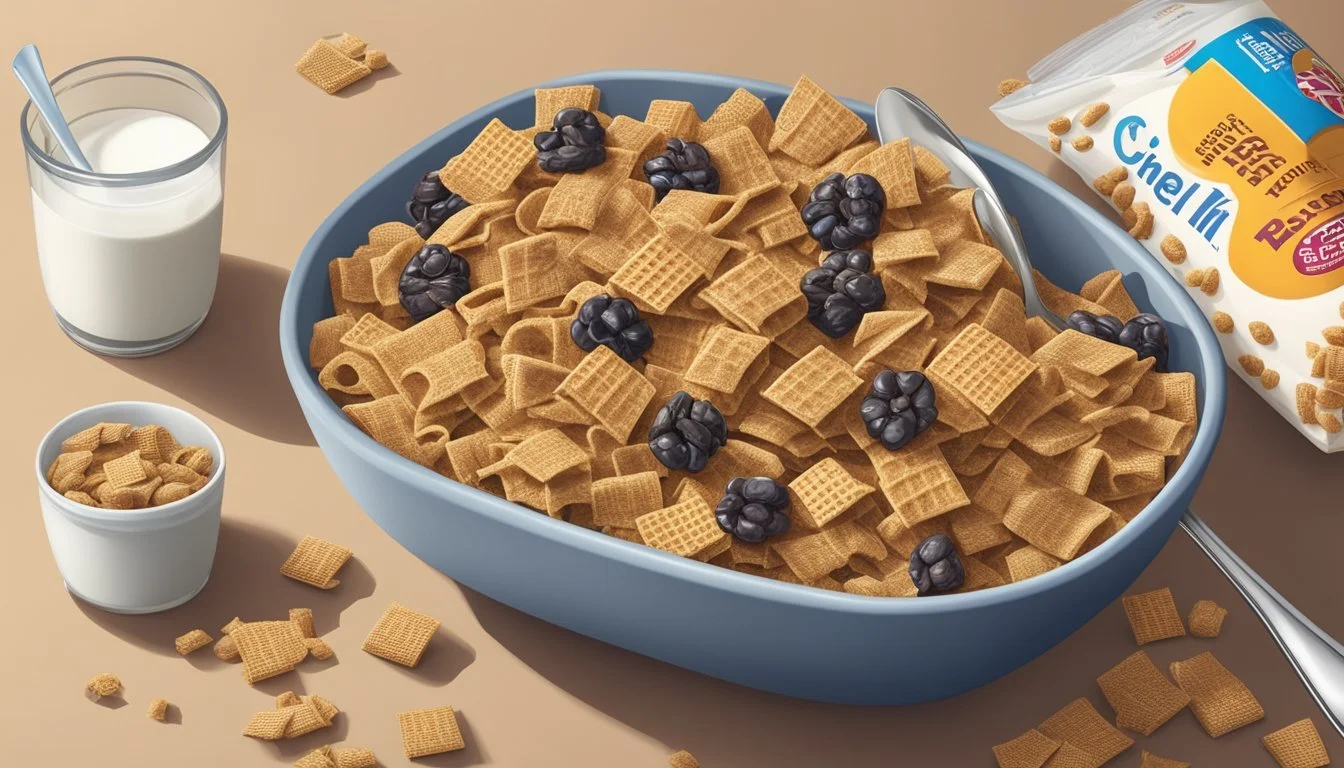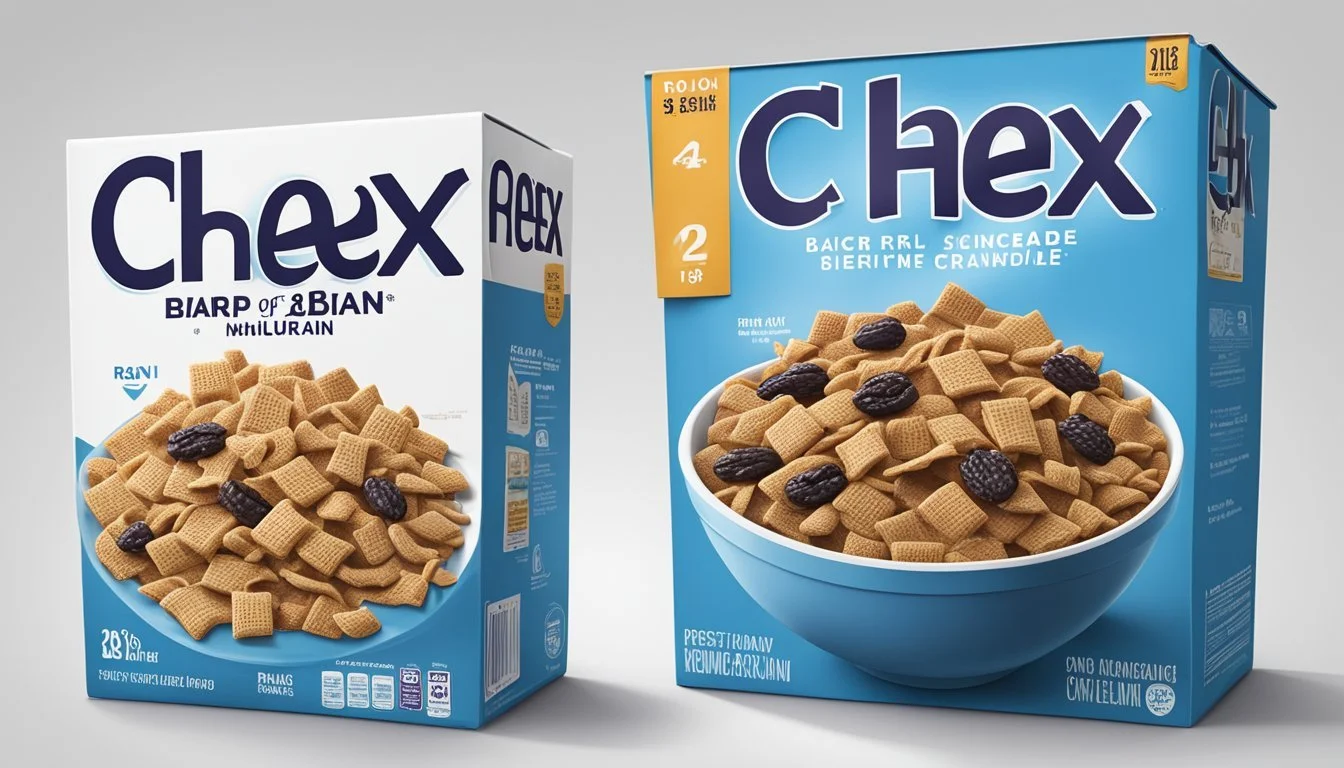Chex vs Post Raisin Bran Cereal
Nutritional Comparison and Taste Test
This Article is Part of Our Breakfast Cereal Guide with Details on Chex Nutrition and Post Raisin Bran Cereal Nutrition
When choosing between Chex and Post Raisin Bran cereal, important factors like nutritional content and taste preferences come into play. Post Raisin Bran offers a slightly higher calorie count but provides a moderate amount of protein and is a flavorful option filled with raisins. This makes it appealing to those who enjoy a sweet start to their day while still getting some health benefits.
On the other hand, Wheat Chex provides a crunchier texture with less sugar and higher fiber content, making it a great choice for those focused on maintaining a balanced diet. It is also available in gluten-free varieties, catering to those with dietary restrictions.
Each cereal has unique nutritional advantages. The key is understanding which aligns best with your dietary goals and taste preferences.
Cereal Overview
Breakfast cereals, including Chex and Post Raisin Bran, are staples in many households. The history and evolution of these cereals highlight significant cultural and health trends.
History of Breakfast Cereals
The origins of breakfast cereals date back to the late 19th century. Early cereals were developed as health foods by pioneers such as Dr. John Harvey Kellogg. Kellogg's, a major player, introduced Corn Flakes in the 1900s, revolutionizing breakfast habits.
General Mills followed with products like Chex, offering variety and texture. The introduction of Post cereals, including Raisin Bran, provided more choices. Post Raisin Bran, created by the Post Consumer Brands company, became known for its mix of raisins and whole grain flakes.
Rise of Health-Conscious Breakfast Choices
In recent years, there has been a shift towards more health-conscious breakfast options. Consumers are increasingly interested in nutritional content, seeking cereals low in sugar and high in fiber and protein.
Wheat Chex, produced by General Mills, is praised for its whole-grain ingredients and moderate sugar content. Similarly, Post Raisin Bran is marketed for its fiber content and inclusion of natural fruit.
The emphasis on healthy eating has led to more transparent labeling and the development of gluten-free varieties, catering to dietary restrictions and preferences.
Nutritional Comparison
This section provides a detailed examination of the nutritional aspects of Chex and Post Raisin Bran cereals, focusing on macronutrients, vitamins and minerals, and dietary fiber content for digestive health.
Macronutrients in Chex and Post Raisin Bran
Protein and Fat Content
Chex and Post Raisin Bran offer different macronutrient profiles. A serving of Corn Chex typically contains 1 gram of protein and 0 grams of fat. By comparison, a serving of Post Raisin Bran contains 3 grams of protein and 1 gram of fat. Higher protein content in Post Raisin Bran may be beneficial for individuals seeking to increase their daily protein intake.
Caloric Content
Caloric intake is another critical factor. Corn Chex provides about 120 calories per serving. Post Raisin Bran, on the other hand, has a slightly lower caloric count at 100 calories per serving. For those monitoring calorie consumption, especially in the context of weight management, these differences can be significant.
Sodium and Sugars
Sodium content can affect heart health. Corn Chex has 280 milligrams of sodium per serving, which is higher compared to the 200 milligrams found in Post Raisin Bran. As for sugars, Post Raisin Bran is known for its higher sugar content, mainly from the raisins used, which can be a downside for those monitoring sugar intake.
Vitamin and Mineral Content Analysis
Essential Vitamins
Both Corn Chex and Post Raisin Bran are fortified with essential vitamins. Corn Chex generally includes vitamins such as Vitamin A, Vitamin C, and several B vitamins including B6 and B12. Post Raisin Bran also offers a range of B vitamins but often has a higher concentration of iron and essential nutrients due to the added raisins.
Minerals
Mineral content is crucial for overall health. Corn Chex provides a balanced offering of calcium, iron, and magnesium. In contrast, Post Raisin Bran typically has higher iron content, beneficial for those at risk of or suffering from anemia.
Percentage Daily Values
Considering FDA recommendations, both cereals meet various daily vitamin and mineral requirements, but Post Raisin Bran tends to have a higher percentage of essential minerals per serving. This can be advantageous for meeting daily nutritional requirements.
Assessing Fiber Content for Digestive Health
Dietary Fiber Comparison
Dietary fiber is an essential component for digestive health. Corn Chex contains 0 grams of dietary fiber per serving, making it less suitable for those looking to boost their fiber intake. Conversely, Post Raisin Bran is richer in dietary fiber, providing around 7 grams per serving, which aligns with the FDA's recommendation for daily fiber intake.
Health Implications
High fiber content in Post Raisin Bran aids in digestive health, preventing constipation and promoting regular bowel movements. This higher fiber content also helps in maintaining a healthy weight and reducing the risk of digestive disorders.
Conclusion on Fiber
Individuals seeking to improve their digestive health will benefit more from the higher dietary fiber content found in Post Raisin Bran compared to Corn Chex.
Health Considerations
Both Chex and Post Raisin Bran have distinct nutritional profiles that can impact health in various ways. The following sections will cover the effects of sugar and preservatives, the benefits of whole grains, and the role of breakfast in daily caloric intake.
Effects of Sugar and Preservatives
Sugar content is a critical factor in determining the healthiness of a cereal. Post Raisin Bran contains added sugars, which can contribute to daily sugar intake and impact blood sugar levels.
Post Raisin Bran:
Sugar per serving: 18g
Added sugars are substantial, contributing to potential health risks if consumed regularly.
Chex tends to have lower sugar content, making it a potentially healthier option for those monitoring their sugar intake.
Corn Chex: 2g of sugar per serving.
Wheat Chex: 5g of sugar per serving.
Preservatives, commonly used to extend shelf life, can also be a concern. Opting for cereals with fewer preservatives can be healthier in the long run.
Benefits of Whole Grains in Diet
Whole grains provide complex carbohydrates and are a good source of dietary fiber. Post Raisin Bran offers the benefits of bran, which is high in fiber and can support digestive health.
Post Raisin Bran: 6g of dietary fiber per serving.
Chex, especially Wheat Chex, incorporates whole grains that deliver essential nutrients.
Wheat Chex: First ingredient is whole-grain wheat.
Fiber content: 6g per serving.
Whole grains are also rich in antioxidants, promoting overall health and well-being. Including whole-grain cereals in the diet can help maintain steady energy levels throughout the day.
Role of Breakfast in Daily Caloric Intake
Breakfast cereals play an important role in daily caloric intake. The caloric content of each cereal can influence weight management and energy levels.
Post Raisin Bran:
Calories per serving: 120
Chex:
Corn Chex: 110 calories per serving.
Wheat Chex: 100 calories per serving.
A balanced breakfast with the right caloric content helps in maintaining energy levels and can contribute to a healthier diet. Including cereals that are low in added sugars and high in whole grains can be a significant part of a nutritious breakfast.
Ingredient Profile
Examining the ingredient profiles of Chex and Post Raisin Bran cereals reveals key differences in whole grain content and the types of sweeteners and fruit included. This section highlights these distinctions to help readers make an informed choice.
Identifying Whole Grain Ingredients
Whole grains are a primary component of both Chex and Post Raisin Bran cereals.
Chex, especially Corn Chex, primarily uses whole grain corn as its base ingredient. This provides a robust source of fiber and essential nutrients.
Post Raisin Bran, on the other hand, incorporates whole grain wheat as its main ingredient, ensuring a significantly higher fiber content. Additionally, the inclusion of bran offers extra dietary fiber.
The inclusion of whole grain ingredients aids in digestion and provides long-lasting energy, making both cereals beneficial for a healthy diet.
Comparison of Sweeteners and Fruit Content
Sweeteners and fruit content also differ markedly between Chex and Post Raisin Bran.
Chex tends to be lower in sugar, contributing only minimal natural sugars from the grains. For example, Corn Chex provides a basic taste profile with fewer added sugars, making it a lower-calorie option.
Post Raisin Bran includes raisins, which are a natural form of sweetener but also contribute additional sugar. This cereal does not typically include nuts or fresh fruit but relies on dried fruits for both sweetness and dietary benefits.
The sweeteners and fruit choices aim to balance taste with nutrition, appealing to those looking for a touch of sweetness or additional fiber in their breakfast options.
Consumer Experience
Consumers often compare the taste, variety, and availability of Chex and Post Raisin Bran cereals when shopping in the grocery store.
Variety and Availability in the Grocery Store
Chex offers a wide range of flavors such as Corn Chex, Rice Chex, and Cinnamon Chex. This gives consumers the flexibility to choose based on their taste preferences. Post Raisin Bran, on the other hand, mainly focuses on a single type that combines bran flakes with raisins.
Availability also plays a big role in consumer experience. Chex products are commonly found in most cereal aisles and are often stocked by major grocery chains. Post Raisin Bran is also readily available, although it generally occupies less shelf space compared to the multiple varieties of Chex.
When examining other cereals, like Cheerios, Grape Nuts, and Rice Krispies, shoppers often notice that Chex's variety stands out. Both Chex and Post Raisin Bran are usually rated similarly for overall satisfaction, which includes factors like taste and availability in stores.
Serving Size and Usage
Chex and Post Raisin Bran offer contrasting serving sizes and nutritional profiles. Understanding how to adapt these cereals to fit dietary needs can help make healthier choices.
Understanding Portion Size and Servings
Portion sizes can greatly impact the nutritional benefits of a cereal. A standard serving of Corn Chex is 1 cup, weighing 1 ounce. In contrast, Post Raisin Bran has a smaller serving size of 0.67 cups, yet it weighs 1.33 ounces due to the density of added raisins.
These differences in serving weight affect calorie count and other nutritional factors. Corn Chex offers 110 calories per serving, while Post Raisin Bran provides 120 calories. It's important to consider these varying serving sizes when evaluating which option aligns with dietary goals.
Adapting Cereal to Fit Dietary Requirements
Adjusting cereal consumption based on dietary requirements can optimize nutritional intake. For those aiming to reduce calorie intake, Corn Chex's 1 cup serving size might be beneficial. Its larger volume can help feel fuller despite its 110 calories.
For additional protein, Post Raisin Bran may be preferable as it offers 3 grams of protein compared to Corn Chex's 2 grams. Observing serving sizes is crucial for managing sugar intake as well. Post Raisin Bran contains added sugars from raisins, influencing total sugar content per serving.
Adapting servings based on individual dietary needs can help make more informed choices, fostering a path towards a more healthy breakfast.
Cereal Alternatives
In exploring better-for-you cereal options, one might consider both grain-free and paleo choices, as well as nutritious alternatives like muesli and oatmeal. These options offer a range of nutrients and can cater to diverse dietary needs.
Exploring Grain-Free and Paleo Options
Grain-free and paleo cereals have surged in popularity, especially among individuals looking to minimize their intake of traditional grains like corn, wheat, and rice. Grain-free cereals often replace grains with ingredients such as nuts, seeds, and flax, providing a nutrient-dense breakfast option. Brands like Paleo Hero and Forager Project offer cereals that cater to these dietary needs, incorporating elements like coconut, almond flour, and seeds.
Paleo cereals frequently emphasize higher protein and fiber content while excluding gluten and refined sugars. These products are beneficial for those adhering to specific dietary restrictions yet seeking a satisfying, crunchy breakfast.
Incorporating Cereal Alternatives Like Muesli and Oatmeal
Muesli and oatmeal serve as excellent cereal alternatives that focus on whole, nutrient-packed ingredients. Muesli typically combines rolled oats, seeds, and dried fruit, such as berries, creating a balanced mix of carbohydrates, fibers, and proteins. Adding soy milk or yogurt can further enrich the nutritional profile.
Oatmeal remains a staple, renowned for its high fiber content and versatility. One can enhance oatmeal with toppings like nuts, fruit, and flax seeds to boost its nutrient value. Both options are generally lower in sugar compared to traditional cereals like Froot Loops or Lucky Charms, making them preferable for a healthier diet.
Switching to these alternatives offers a diverse array of nutrition without compromising on flavor or satisfaction.
Nutritional Labeling and Standards
Nutritional labeling provides essential information to help consumers make informed choices. When comparing cereals like Chex and Post Raisin Bran, understanding the guidelines and nutritional content is crucial.
Interpreting the USDA and FDA Guidelines
The USDA and FDA provide clear guidelines on nutritional labeling. These labels must include macronutrients such as carbohydrates, proteins, and fats. They also cover micronutrients like vitamins and minerals.
Labels are required to list contents per serving, including sodium, potassium, calcium, iron, and zinc. According to FDA recommendations, the daily value percentages must be based on a standard 2,000-calorie diet.
Understanding these values helps consumers meet daily nutritional needs and avoid excess intake of sodium or added sugars, which are particularly highlighted on labels.
Comparing Nutritional Information Across Brands
Comparing Chex and Post Raisin Bran reveals differences in essential nutrients. Post Raisin Bran, for instance, contains:
Sodium: 250 mg
Potassium: 320 mg
Calcium: Approximately 26 mg
Iron: 10.8 mg
Protein: 5 g
Carbohydrates: 46 g (with 8 g dietary fiber and 19 g sugars)
Chex may vary in nutritional content but typically contains less sugar and more complex carbohydrates. Accurate comparisons should always check the nutrition facts panel.
Consumers should note additions like preservatives or added sugars. This helps in identifying healthier options and ensuring compliance with dietary recommendations.
More on Chex
More on Post Raisin Bran Cereal
Cinnamon Toast Crunch vs Post Raisin Bran Cereal: Which is better?
French Toast Crunch vs Post Raisin Bran Cereal: Which is better?
Honey Nut Cheerios vs Post Raisin Bran Cereal: Which is better?
Kellogg's Apple Jacks vs Post Raisin Bran Cereal: Which is better?
Kellogg's Froot Loops vs Post Raisin Bran Cereal: Which is better?
Post GrapevsNut Flakes vs Post Raisin Bran Cereal: Which is better?








